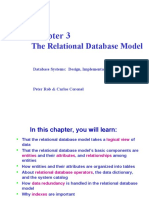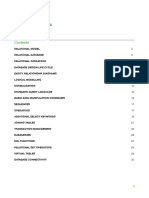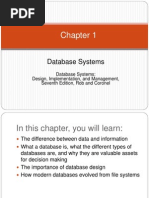0 ratings0% found this document useful (0 votes)
57 viewsChapter 3: Data Relational Model: Prepared By: Norzelan Bin Saleh
The document discusses the relational data model and relational algebra operators. It defines key concepts in the relational model including tables, records, attributes, domains, keys, and relationships. It also explains the major relational algebra operators like select, project, join, union, difference and their uses in manipulating data in relational tables.
Uploaded by
Norzelan SalehCopyright
© © All Rights Reserved
Available Formats
Download as PPT, PDF, TXT or read online on Scribd
0 ratings0% found this document useful (0 votes)
57 viewsChapter 3: Data Relational Model: Prepared By: Norzelan Bin Saleh
The document discusses the relational data model and relational algebra operators. It defines key concepts in the relational model including tables, records, attributes, domains, keys, and relationships. It also explains the major relational algebra operators like select, project, join, union, difference and their uses in manipulating data in relational tables.
Uploaded by
Norzelan SalehCopyright
© © All Rights Reserved
Available Formats
Download as PPT, PDF, TXT or read online on Scribd
You are on page 1/ 42
CHAPTER 3 : DATA RELATIONAL MODEL
Prepared by : Norzelan bin Saleh
Relational model
Enables programmer to view data logically rather than
physically
Relational Model
A database is a collection of information that is organized so
that it can easily be accessed, managed, and updated.
In one view, databases can be classified according to types of
content: bibliographic, full-text, numeric, and images.
What is Database?
Table: two-dimensional structure composed of rows and
columns
Components of database table are :
Record (tuple) - is a sequence of attributes i.e. a row in the relation
table.
Attribute (field) - is a named column in the relation table.
Domain - The domain of an attribute defines the set of values which can
apply to that attribute.
Degree - The degree of a relation refers to the number of attributes in
each tuple.
Cardinality - This refers to the number of tuples in the relation
Components of Database Table
Relation Schema: relation name + attribute names + domain
Relation name
Attribute name
Domains
Characteristic of Relation Scheme
Consists of one or more attributes that determine other
attributes.
Keys
Primary Key - Primary key (PK) is an attribute (or a
combination of attributes) that uniquely identifies any given
entity (row)
Superkey - Any key that uniquely identifies each row
Candidate key - A superkey without redundancies
Composite key - Composed of more than one attribute
Foreign key a field in a relational table that matches the
primary key column of another table. The foreign key can be
used to cross-reference tables
Entity Integrity
Referential Integrity - FK contains a value that refers to an existing valid
tuple (row) in another relation
Integrity Rules
Relational Model Relationship
One entity
related to
another of
the same
entity type
Entities of
two different
types related
to each other
Entities of three
different types
related to each
other
Each entity in the relationship will have exactly one related
entity
One to Many Relationship
Entities on both sides of the relationship can have many related
entities on the other side
Many to Many Relationship
Converting the M:N relationship into TWO 1:M relationships
Foreign keys reference the primary keys in the other
tables of which it has a relationship with
The database designer has 2 main options to define
a composite tables primary key:
either
use the combination of those foreign keys or
create a new primary key.
Self-referencing relationships are a special case of a normal
table relationship.
The only difference is that in this case, there is only one table
involved and it is on both sides of the relationship.
Example :
One common example is an Employees table that contains information
about the supervisor of each employee. Each supervisor is also an
employee and has his or her own supervisor. In this case, there is a one-
to-many self-referencing relationship, as each employee has one
supervisor but each supervisor may have more than one employee.
Self Referencing Relationship
Relational algebra
Defines theoretical way of manipulating table contents using relational
operators
Use of relational algebra operators on existing tables (relations)
produces new relations
Relational Database Algebra
Restrict (select)
Project
Join (outer, inner)
Cartesian Product
Yields values for all rows found in a table
Can be used to list either all row values or it can yield only those row
values that match a specified criterion
Yields a horizontal subset of a table
Select
Yields all values for selected attributes
Yields a vertical subset of a table
Project
Allows information to be combined from two or more tables
Real power behind the relational database, allowing the use of
independent tables linked by common attributes
Join
Outer join:
Matched pairs are retained and any unmatched values in other table
are left null
In outer join for tables CUSTOMER and AGENT, two scenarios are
possible:
Left outer join
Yields all rows in CUSTOMER table, including those that do not
have a matching value in the AGENT table
Right outer join
Yields all rows in AGENT table, including those that do not have
matching values in the CUSTOMER table
Inner Join
An inner join (sometimes called a simple join) is a join of two or more
tables that returns only those rows that satisfy the join condition.
Traditional inner joins look for rows that match rows in the other
table(s), i.e. to join two tables based on values in one table being equal
to values in another table
Also known as equality join, equijoin or natural join
Returns results only if records exist in both tables
Database Systems: Design, Implementation, &
Management, 7
th
Edition, Rob & Coronel
Relational Algebra Operators (continued)
Union:
Combines all rows from two tables, excluding duplicate
rows
Tables must have the same attribute characteristics
Intersect:
Yields only the rows that appear in both tables
Database Systems: Design, Implementation, & Management, 7
th
Edition, Rob & Coronel
Relational Algebra Operators
(continued)
Database Systems: Design, Implementation, & Management, 7
th
Edition, Rob & Coronel
Relational Algebra Operators
(continued)
Database Systems: Design, Implementation, &
Management, 7
th
Edition, Rob & Coronel
Relational Algebra Operators (continued)
Difference
Yields all rows in one table not found in the other
table that is, it subtracts one table from the
other
Product
Yields all possible pairs of rows from two tables
Also known as the Cartesian product
Database Systems: Design, Implementation, & Management, 7
th
Edition, Rob & Coronel
Relational Algebra Operators
(continued)
Database Systems: Design, Implementation, & Management, 7
th
Edition, Rob & Coronel
Relational Algebra Operators
(continued)
Database Systems: Design, Implementation, & Management, 7
th
Edition, Rob & Coronel
Relational Algebra Operators
(continued)
Database Systems: Design, Implementation, &
Management, 7
th
Edition, Rob & Coronel
Relational Algebra Operators (continued)
DIVIDE requires the use of one single-column
table and one two-column table
Database Systems: Design, Implementation, & Management, 7
th
Edition, Rob & Coronel
Relational Algebra Operators
(continued)
You might also like
- 5 - CC104 - Relational Model Characteristics 1No ratings yet5 - CC104 - Relational Model Characteristics 132 pages
- The Relational Database Model: Database Systems: Design, Implementation, and ManagementNo ratings yetThe Relational Database Model: Database Systems: Design, Implementation, and Management52 pages
- Chapter 3-Database Systems Eighth Edition PresentationNo ratings yetChapter 3-Database Systems Eighth Edition Presentation55 pages
- Advance Database Systems: Overview of Data ModelingNo ratings yetAdvance Database Systems: Overview of Data Modeling33 pages
- CSC 263 Database Systems: Salem State University Computer Science DepartmentNo ratings yetCSC 263 Database Systems: Salem State University Computer Science Department55 pages
- 5.Introduction to relational databases Relational Model KeysNo ratings yet5.Introduction to relational databases Relational Model Keys7 pages
- Database Management Systems: Relational Data Model Year II 2024/25No ratings yetDatabase Management Systems: Relational Data Model Year II 2024/2519 pages
- 1 Model Structure.: Lesson 6 The Relational Data Model IiNo ratings yet1 Model Structure.: Lesson 6 The Relational Data Model Ii5 pages
- Database Systems: Design, Implementation, and Management: The Relational Database ModelNo ratings yetDatabase Systems: Design, Implementation, and Management: The Relational Database Model52 pages
- The Relational Data Model and Relational Database ConstraintsNo ratings yetThe Relational Data Model and Relational Database Constraints20 pages
- Relational Data Modal 11 lacture-WPS OfficeNo ratings yetRelational Data Modal 11 lacture-WPS Office24 pages
- chapter 6 relational algebra and calculusNo ratings yetchapter 6 relational algebra and calculus22 pages
- 1) ER Diagrams: Mapping Cardinality Representation Using ER DiagramNo ratings yet1) ER Diagrams: Mapping Cardinality Representation Using ER Diagram15 pages
- Relational Theory and Relational DatabasesNo ratings yetRelational Theory and Relational Databases12 pages
- Sql Simplified:: Learn to Read and Write Structured Query LanguageFrom EverandSql Simplified:: Learn to Read and Write Structured Query LanguageNo ratings yet
- Course Outline: OCCUPATIONAL SAFETY AND HEALTH Course Is Designed To Impart100% (2)Course Outline: OCCUPATIONAL SAFETY AND HEALTH Course Is Designed To Impart5 pages
- Chapter 3: Data Relational Model: Prepared By: Norzelan Bin SalehNo ratings yetChapter 3: Data Relational Model: Prepared By: Norzelan Bin Saleh42 pages
- The Relational Database Model: Database Systems: Design, Implementation, and ManagementThe Relational Database Model: Database Systems: Design, Implementation, and Management
- Chapter 3-Database Systems Eighth Edition PresentationChapter 3-Database Systems Eighth Edition Presentation
- Advance Database Systems: Overview of Data ModelingAdvance Database Systems: Overview of Data Modeling
- CSC 263 Database Systems: Salem State University Computer Science DepartmentCSC 263 Database Systems: Salem State University Computer Science Department
- 5.Introduction to relational databases Relational Model Keys5.Introduction to relational databases Relational Model Keys
- Database Management Systems: Relational Data Model Year II 2024/25Database Management Systems: Relational Data Model Year II 2024/25
- 1 Model Structure.: Lesson 6 The Relational Data Model Ii1 Model Structure.: Lesson 6 The Relational Data Model Ii
- Database Systems: Design, Implementation, and Management: The Relational Database ModelDatabase Systems: Design, Implementation, and Management: The Relational Database Model
- The Relational Data Model and Relational Database ConstraintsThe Relational Data Model and Relational Database Constraints
- 1) ER Diagrams: Mapping Cardinality Representation Using ER Diagram1) ER Diagrams: Mapping Cardinality Representation Using ER Diagram
- Sql Simplified:: Learn to Read and Write Structured Query LanguageFrom EverandSql Simplified:: Learn to Read and Write Structured Query Language
- Excel: A Comprehensive Guide: The IT CollectionFrom EverandExcel: A Comprehensive Guide: The IT Collection
- Course Outline: OCCUPATIONAL SAFETY AND HEALTH Course Is Designed To ImpartCourse Outline: OCCUPATIONAL SAFETY AND HEALTH Course Is Designed To Impart
- Chapter 3: Data Relational Model: Prepared By: Norzelan Bin SalehChapter 3: Data Relational Model: Prepared By: Norzelan Bin Saleh
































































